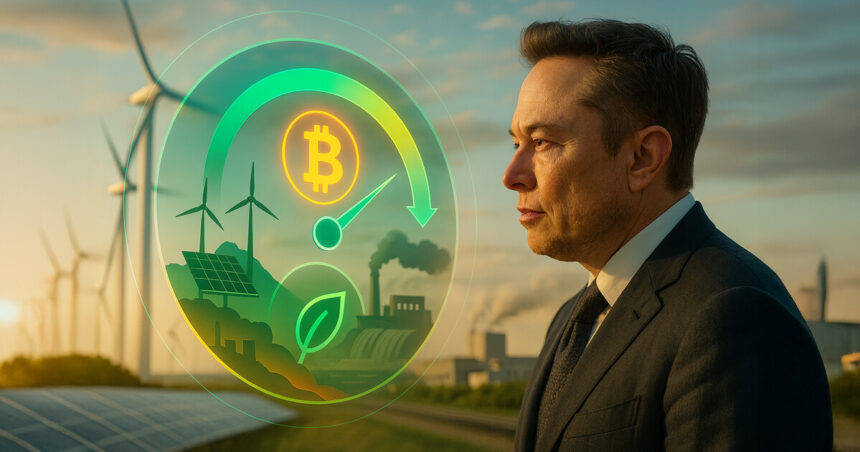Elon Musk just lately reinstated the “51% renewable power” benchmark and stated the power behind Bitcoin “can't be faked.”
The point out refers to his earlier promise that Tesla would resume accepting Bitcoin funds as soon as not less than half of the power it mines comes from clear or low-carbon sources.
Nonetheless, Tesla has but to re-enable BTC checkout, though the newest knowledge suggests the community might have crossed that threshold. why?
Has Bitcoin reached its restrict but?
In accordance with the Cambridge Heart for Different Finance's 2025 Digital Mining Trade Report, roughly 52.4% of surveyed Bitcoin mining exercise is presently powered by sustainable power.
Of this, 42.6% comes from renewable power (hydro, wind, photo voltaic, and so forth.) and 9.8% from nuclear or different low-carbon sources. In parallel, the contribution of fossil fuels has additionally modified, with pure fuel now accounting for 38.2% (up from about 25% in 2022) and coal falling to eight.9% (down from about 36.6%).

If we take Musk's promise actually, Bitcoin might already move the 51% “sustainable power” threshold, not less than as measured by a Cambridge survey of corporations masking about 48% of the world's mining capability.
However that is solely half the story. Language is vital. Musk talked about renewable power (50%) in his earlier feedback, however in a subsequent tweet he additionally stated it was “51% renewable” or “power that may't be faked.” The Cambridge figures lump renewable power and nuclear power collectively. The share of pure renewable power is decrease (42.6%).
Subsequently, relying on the strictness of Mr. Musk's definition, BTC should fall quick.
Moreover, the Cambridge strategy is research-based and solely targets a choose group of minors. Off-grid operations, renewable power reductions, regional specificities, and temporal mismatches (the place renewable power era happens roughly than mining demand) complicate the scenario.
Different fashions, reminiscent of fashions based mostly on grid carbon depth or power monitoring, usually yield extra conservative estimates of the share of renewable power. This disconnect implies that even a nominal “move” is topic to debate.
So why didn't Tesla flip the change?
Even acknowledging that Bitcoin could also be topic to Musk's sustainability assessments, Tesla has not re-enabled Bitcoin funds. A number of sensible and symbolic hurdles stay.
The primary is due diligence. Musk beforehand stated Tesla would solely resume funds if it noticed “affordable (about 50%) clear power utilization…and a pattern towards rising that quantity.” This wording suggests he's on the lookout for permanence quite than a one-time knowledge level.
A single report displaying 52% sustainable power might not meet his requirement of a verified sustained upward pattern in Bitcoin's power combine.
One other issue is readability of definition. Tesla must resolve whether or not “sustainable” contains nuclear energy and low-carbon sources, or absolutely renewable power reminiscent of hydro, wind and solar energy. The Cambridge knowledge combines these classes, however Musk's earlier language particularly referred to renewable power.
With no broadly accepted definition, the choice to restart BTC funds dangers being accused of greenwashing.
There’s additionally the difficulty of vendor and market threat. Accepting Bitcoin exposes Tesla to cost volatility, advanced accounting, and potential regulatory issues.
Even when the corporate have been to right away convert its BTC receipts into fiat foreign money, the fluctuations between order placement and settlement create monetary uncertainty that might not be well worth the effort for automakers with low revenue margins.
Branded optical parts add a brand new layer. Tesla's picture is constructed on environmental credibility, and even a slight setback in Bitcoin's power profile might trigger a backlash from traders and ESG-minded clients. The corporate could also be higher off erring on the aspect of warning quite than exposing itself to new criticism if mining operations return to fossil-rich areas.
Lastly, operational integration can’t be ignored. To convey Bitcoin funds again on-line, Tesla might want to rebuild its pockets infrastructure, transaction pipeline, and conversion mechanism. It requires engineering sources and inside approval. This step is not any small feat for a worldwide producer already balancing a number of product launches and software program initiatives.
Taken collectively, these elements present that assembly the 51% renewable power commonplace shouldn’t be sufficient. For Musk, this take a look at appears to be as a lot about confidence, consistency and consciousness as uncooked knowledge. Till these match, Tesla's checkout web page will seemingly stay unencrypted.
What this implies for adoption
From a story perspective, Musk's re-engagement has had an affect. A extra sustainable story for cryptocurrencies shall be strengthened if Bitcoin can reliably transition to a cleaner power combine and main industrial offers like Tesla can begin buying and selling once more.
Nonetheless, Tesla's continued off-chain standing regardless of the claims means that Musk views the promise as conditional quite than automated. This take a look at focuses not solely on easy metrics but additionally on optics, threat administration, and narrative.
For now, Bitcoin's claimed “greater than 51% sustainable” standing is a convincing rebuttal to its critics, however till checkouts return, it is going to stay extra of a symbolic victory than a industrial one.
(Tag Translation) Bitcoin


